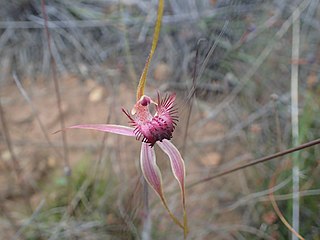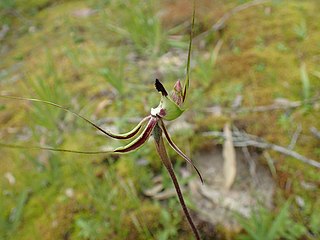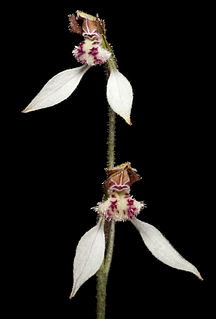
Eriochilus, commonly known as bunny orchids, is a genus of flowering plants in the orchid family, Orchidaceae that is endemic to Australia. Orchids in this genus are distinguished from those in the similar Caladenia by having a glabrous leaf and a densely woolly labellum. Species occur in south-west Western Australia, South Australia, Queensland, New South Wales, the Australian Capital Territory, Victoria, and Tasmania. Their common name alludes to their prominent ear-like lateral sepals.

Caladenia cruscula, commonly known as the reclining spider orchid is a species of orchid endemic to a small area in the south-west of Western Australia. It has a single hairy leaf and a single cream-coloured flower with a long red fringe on the sides of its labellum.

Caladenia decora, commonly known as the Esperance king spider orchid is a species of orchid endemic to the south-west of Western Australia. It has a single hairy leaf and up to three red, yellow and green flowers. It is a variable species, similar to the king spider orchid and sometimes hybridises with other species so that it can be difficult to recognise, but is one of the largest spider orchids found in Western Australia.

Caladenia exstans, commonly known as the pointing spider orchid, is a species of orchid endemic to a small area in the south-west of Western Australia. It has a single, hairy leaf and one or two green, yellow and red flowers with a labellum which does not curl downwards but "points" forward.

Caladenia horistes, commonly known as the cream spider orchid is a species of orchid endemic to the south-west of Western Australia. It has a single, hairy leaf and one or two, creamy-yellow flowers which have a red-striped labellum and long, dark, thread-like tips on the sepals and petals.

Caladenia longicauda subsp. rigidula, commonly known as the rigid white spider orchid or island white spider orchid, is a plant in the orchid family Orchidaceae and is endemic to the south-west of Western Australia. It has a single hairy leaf and up to three large, mainly white flowers with relatively short lateral sepals and petals. It is similar to the reclining white spider orchid but that species has smaller, cream-coloured flowers.
Caladenia longicauda subsp. insularis, commonly known as the island white spider orchid is a plant in the orchid family Orchidaceae and is endemic to the south-west of Western Australia. It has a single hairy leaf and up to four yellowish-white flowers with long, mostly spreading lateral sepals and petals. It is a relatively rare, self-pollinating subspecies and often flowers which are in bud, open and finished are seen on a single plant.

Caladenia microchila, commonly known as the western wispy spider orchid, is a species of orchid endemic to the south-west of Western Australia. It is relatively common orchid with a single erect, hairy leaf and up to three wispy white flowers with narrow lateral sepals and petals and a white labellum with red markings.
Microtis cupularis, commonly known as the cupped mignonette orchid sometimes as Hydrorchis cupularis, is a species of orchid endemic to the south-west of Western Australia. It has a single thin, hollow, onion-like leaf and up to thirty small, yellowish-green and red flowers. The plants often grow in shallow water and are self-pollinating.

Eriochilus helonomos, commonly known as the swamp bunny orchid, is a plant in the orchid family Orchidaceae and is endemic to Western Australia. It has a single pointed leaf and usually a single white or cream-coloured flower with reddish brown markings. A relatively common species, it usually grows in swampy places. It is distinguished from other bunny orchids by the arrangement of its petals.

Eriochilus dilatatus subsp. dilatatus, commonly known as the white bunny orchid, is a plant in the orchid family Orchidaceae and is endemic to Western Australia. It has a single narrow leaf and up to seven greenish and white flowers with reddish or mauve markings. A widespread and common species, it grows in a range of habitats and flowers prolifically after fire.
Eriochilus dilatatus subsp. brevifolius, commonly known as the blunt-leaved bunny orchid, is a plant in the orchid family Orchidaceae and is endemic to Western Australia. It has a single small, smooth leaf with wavy edges and a pale red lower surface, and up to three greenish and white flowers with red or mauve markings. It is distinguished from the other subspecies by the colour of the lower surface of its leaf and by its later flowering period.
Eriochilus dilatatus subsp. magnus, commonly known as the Easter bunny orchid, is a plant in the orchid family Orchidaceae and is endemic to Western Australia. It has a single large, smooth, flattened leaf and up to twenty five dull green, red and white flowers. It is found in high rainfall areas between Perth and Albany.
Eriochilus dilatatus subsp. multiflorus, commonly known as the common bunny orchid, is a plant in the orchid family Orchidaceae and is endemic to Western Australia. It has a single short, smooth, flattened, egg-shaped leaf and up to twenty dull green, red and white flowers which are often closely packed. It grows in forest and woodland between Perth and Albany.
Eriochilus dilatatus subsp. orientalis, commonly known as the eastern bunny orchid, is a plant in the orchid family Orchidaceae and is endemic to Western Australia. It has a single short, smooth, flattened, egg-shaped leaf and up to seven dull green, red and white flowers on a fleshy flowering stem. It only occurs on the coast near Caiguna.

Eriochilus dilatatus subsp. undulatus, commonly known as the crinkle-leaved bunny orchid, is a plant in the orchid family Orchidaceae and is endemic to Western Australia. It has a common orchid in the wheatbelt and has single narrow egg-shaped leaf with wavy edges and a maroon underside. Up to three dull green, red and white flowers are borne on a wiry flowering stem.

Eriochilus dilatatus, commonly known as the white bunny orchid, is a plant in the orchid family Orchidaceae and is endemic to Western Australia. It is a common and widespread, slender ground orchid with a single leaf and up to fifteen small white and greenish flowers with reddish or brownish markings and a hairy labellum.

Eriochilus scaber is a plant in the orchid family Orchidaceae and is endemic to Western Australia. It has a single leaf and up to three small red, pink and white flowers. Two subspecies are recognised based on the shape of the leaf and its height above the ground.
Eriochilus tenuis, commonly known as the slender bunny orchid, is a plant in the orchid family Orchidaceae and is endemic to Western Australia. It has a single egg-shaped leaf lying flat on the ground and one or two small pink or pink and white flowers. A common species, it grows in dense, shrubby forest and in winter-wet swamps.
Eriochilus valens, commonly known as the red-lipped bunny orchid, is a plant in the orchid family Orchidaceae and is endemic to Western Australia. It has a single egg-shaped leaf held above the ground and up to four small pink or white and pink flowers. It grows near winter-west swamps and usually only flowers after fire the previous summer.









